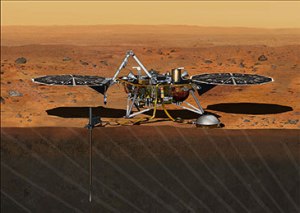Jul 9 2014
Scientists from NASA's InSight mission to Mars have been checking out the lowest vibration sites across the UK in order to find somewhere quiet enough to calibrate the seismometer that will be travelling to the Red Planet in 2016.
 Artist’s impression of the InSight Mars lander. The SEIS will be deployed onto the surface using a robot arm, where it will then record signals from marsquakes and meteorite impacts in order to probe the planet’s interior. Image credit: NASA/JPL-Caltech
Artist’s impression of the InSight Mars lander. The SEIS will be deployed onto the surface using a robot arm, where it will then record signals from marsquakes and meteorite impacts in order to probe the planet’s interior. Image credit: NASA/JPL-Caltech
Recent tests undertaken in the Ultra-Low Noise Lab at the University of Bristol's Centre for Nanoscience and Quantum Information (NSQI) have shown it to be the quietest location in the UK in the critical seismic frequency range that scientists expect to encounter on Mars.
The Short Period Seismometer is the UK’s contribution towards the InSight (Interior Exploration using Seismic Investigations, Geodesy and Heat Transport) mission and makes up half of the Seismic Experiment for Interior Structure (SEIS).
The SEIS is the primary instrument on the probe and is designed to measure signals from marsquakes and meteorite impacts. The mission aims to discover much about the processes that shaped the rocky planets of the inner solar system (including Earth) more than four billion years ago.
Dr Nick Teanby, Dr James Wookey, Jenny Taylor and Dr Anna Horleston from Bristol's School of Earth Sciences have been working with the NSQI’s Dr Pete Dunton to see how the Ultra-Low Noise Lab can be used to help calibrate and test the Mars-bound instrument.
These tests will be some of the most vibration sensitive yet to take advantage of the NSQI's exceptional facility and will be performed by the Bristol team together with collaborators from Imperial College London, the University of Oxford and the Rutherford Appleton Laboratory.